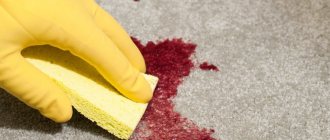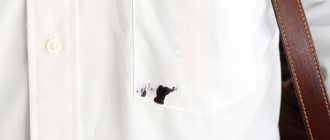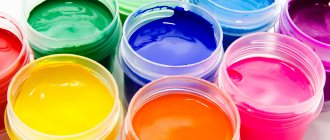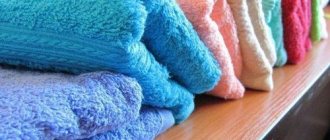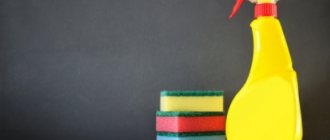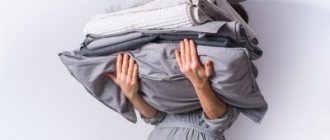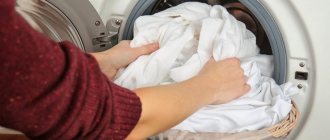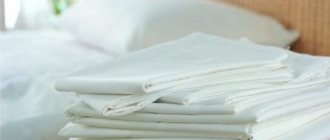Things that have lost their attractive appearance are a misfortune for housewives. With daily washing, the laundry loses its color intensity, becomes faded and untidy. But without it, it is impossible to remove dirt, dust, and sweat. You have to put up with the state of affairs and go to the store for new things or look for effective ways to “reanimate” fabrics. How to wash washed clothes and restore their aesthetic appearance?
Selecting a machine wash mode
To choose the right machine wash mode, you need to focus on the material from which the laundry is made:
- Cotton and linen. Suitable temperature 60 °C. Permissible temperature (for children's bedding) is 90°C. You can set the spin to the maximum number of revolutions. It is better not to use automatic drying. Dry laundry out of direct sunlight.
- Synthetic materials. “Delicate” mode. Temperature 40°C. Automatic drying is not recommended.
- Silk. Maximum temperature 30°C. Drying and spinning are prohibited. For washing, use liquid powder, conditioner and water softener.
- Poplin. Washable just like cotton. Temperature 40–60 °C.
- Satin. Temperature 60°C, if the powder is liquid – 40°C. Maximum spin.
- Batiste and bamboo. “Delicate” mode. Average spin. Temperature up to 40°C.
Choose the temperature mode based on the product label.
How often should you wash your clothes? Ideally, sheets and pillowcases should be changed once a week, duvet covers - once every 2 weeks.
Bleaching Safety
When working with chemicals and hot water, it is important to take care not only of your bed linen, but also of your health. Following safety precautions will help you avoid burns and allergic reactions:
- When using household chemicals, strictly follow the manufacturer's instructions. Using overdoses of bleach does not affect the degree of lightening, but produces more harmful fumes. In people with hypersensitivity, this causes allergic reactions and breathing problems.
- When boiling or bleaching with aggressive substances, protect your eyes, hands, and lungs. Wear a mask and gloves.
As you can see, there is no difficulty in bleaching your laundry at home. The main thing is to choose the right product and follow the instructions. Then the shining whiteness of sheets and pillowcases will become familiar.
Boiling
This method is suitable for bedding made of cotton or linen, as they tolerate high temperatures.
Boiling will not only whiten, but also eliminate the unpleasant smell of laundry.
Necessary:
- Prepare an enameled or galvanized tank (pan, bucket).
- Place a towel on the bottom.
- Dissolve powder or laundry soap.
- Place the bedding in the pan, straightening it out.
- To fill with water.
- Add 1 tablespoon of ammonia.
- Boil for 30–60 minutes.
How to bleach varying degrees of soiling
You can also lighten the material by soaking. Unlike boiling, it takes longer, but does not require constant presence and does not damage the fabric.
Gray underwear that was white
Slightly yellowed items can be easily refreshed with eggshells. It must be crushed, poured into a bag and tied tightly with a cord. Place in a bowl of soaked laundry or leave overnight.
Another option is machine washable. Place the bag in the washing drum along with your clothes, add washing powder or gel, and activate the program.
Potassium permanganate is a proven way to whiten gray laundry, which our grandmothers used.
Prepare a pale pink solution, add a glass of washing powder to it (for children's clothes it is better to take laundry soap). Soak for a couple of hours. Afterwards, if necessary, wash away the stains, rinse and put into the machine.
Yellowness
Yellowed sheets can be bleached well using home and pharmacy remedies:
- Mustard powder. Dissolve 400 g in 5 liters of water, soak the laundry for a couple of hours. Then wash in the same water with mustard or with a suitable detergent.
- Ammonia-soda solution. For 10 liters of water - 5 tbsp. l. ammonia, 10 tbsp. l. baking soda. Soak for 3 hours, then wash with powder. The composition is recommended for thin, delicate fabrics.
- Soda Ash. Dissolve 3-4 tbsp. l. powder in a bucket of water, add chopped laundry soap. Keep the laundry for 8-10 hours, then wash.
- Aspirin. Dissolve 7-10 crushed tablets in 5 liters of warm water. Soak the laundry for 10 hours, then wash with soap or powder.
- Composition of turpentine and boric acid (from old stains on flannel). For 8 liters of warm water, take 50 ml of the first drug and 20 ml of the second. Bleach in solution for 1-2 hours, rinse and wash.
Black spots
Bedding may not only turn yellow, but also turn grey. Black dots and spots formed on the fabric are colonies of moldy fungi. They appear if things are put away on the shelf undried or stored in a damp place.
Bedding that is heavily damaged by mold spores should be replaced or taken to dry cleaning. In other cases, store-bought remedies and folk recipes will help. There are several proven ways to safely bleach laundry:
- Whey (yogurt or kefir). Soak overnight, rinse in the morning and wash with powder or soap.
- Ammonia + salt (1:1). Apply the paste onto gray spots and leave for 20 minutes. Remove the composition and wash the product.
- Onion + lemon juice. Apply chopped onion to the stain, leave for a couple of minutes, then pour in lemon juice. Wait 20-30 minutes, remove from fabric, rinse with cold water. Wash the linen.
- Vinegar. Moisten the stains, rub, wait 10-15 minutes, then wash.
Note! When choosing a product, it is necessary to take into account the properties of the fibers. If there are synthetics, then the product should not contain components that corrode the threads.
Industrial bleaches
There are two main types of industrial bleaches:
- Chlorine-containing. Sometimes they leave yellow stains on the fabric and can destroy the fibers.
- Oxygen. They have a more active effect on pollution and are gentle on the material.
How to use:
- Wear rubber gloves.
- Dilute the bleach.
- Soak items for 6–12 hours
- Launder.
- If there are individual spots, apply additional product to them.
Bleaches and stain removers are labeled “Color” if they are suitable for colored laundry. For example: ACE Oxi Magic, Astonish Oxi Plus, Vanish ColorUdalix Oxi Ultra, Sarma Active 5 in 1.
How to use:
- Wash items as usual.
- Apply bleach to stains.
- Wash again, but this time with bleach.
How to whiten white laundry at home
You can restore snow-whiteness with store-bought preparations, and if you don’t trust them, with home remedies. Each of them affects the fabric in its own way, so before bleaching white linen, you need to carefully study the properties of the components.
Special chemicals
Modern preparations are produced for different types of fabric, so it is absolutely safe to restore freshness to things. The main thing is to choose the right product and follow the manufacturer’s instructions. Today there are three types of laundry bleaches at home:
- Chlorine-containing (ACE, “Whiteness”). They effectively remove yellowness and grayness, but have a poor effect on fibers. The threads loosen, dirt gets more clogged into the voids, so the laundry gets dirty faster. Such preparations should only be used for manual bleaching. You should not pour it into the machine, as bleach spoils the parts.
Important! Preparations with chlorine cannot be used to lighten thin cotton fabrics, items with colored patterns and embroidery.
- Oxygen-containing (“Persol”, Lion “Brightness”, Synergetic, Vanish Oxi Action). They do not harm fibers, so they are suitable even for delicate fabrics. Bleaching agents can be used for white and colored laundry.
- Optical (Dr. Beckmann “Dazzling whiteness”, Ecover “Eco-friendly”). They are considered bleaches, although they are not capable of bleaching fabrics. Things appear snow-white due to the visual effect created by particles with reflective properties. The preparations are recommended for refreshing slightly yellowed items.
Traditional methods
If the sheets have turned gray and you don’t have store-bought preparations at hand, you can whiten them with home remedies. Here are just some folk recipes:
- Pour 2 tbsp into a bowl of hot water. l. ammonia and turpentine (or hydrogen peroxide). If the laundry is very dirty, add a glass of washing powder. Immerse things and keep for 4-5 hours. If necessary, change the solution and repeat the operation.
- The following composition will help whiten a silk bed: take 1 tsp per 5 liters of water. peroxide and ammonia, 3 tbsp. l. salt, 50 g washing powder. Soak for 2-3 hours.
- For a silk bed, you can prepare a composition of 1 tbsp. l. ammonia, 6 tbsp. l. salt. Soak for 5-6 hours.
Boiling
The most effective method of bleaching, but only suitable for items made of pure cotton and linen. Contraindicated for silk and products containing synthetic or artificial threads.
You can bleach by boiling in a washing machine (if there is an appropriate program) or the old-fashioned way - on the stove. In the first case, the housewife just needs to load the laundry, add the drug and activate the program. The second method is more labor-intensive:
- Prepare a solution with store-bought or homemade bleach.
- Pour it into a basin (bucket) with cold water, lower the laundry.
- Place the container on the stove.
- Bring to a boil, reduce heat.
- Boil for 30-40 minutes, very worn items - 1-2 hours.
- While boiling, stir occasionally with wooden tongs or a stick.
At the end of boiling, remove the laundry from the basin and rinse. If necessary, wash in an automatic machine or manually.
Advice! Bedding will whiten better if you pre-soak it with powder before boiling.
Reasons for the loss of whiteness
White bed linen becomes gray or even yellow after just a few washes. This happens because some powders contain elements that, when interacting with water salts, color the fabric. But the main enemy of fabric is hard water.
Important! Due to the high concentration of salts, water deteriorates the quality of washing: stains remain on the fabric, the performance characteristics of the product deteriorate, and chemical compounds that are harmful to the skin remain in the fibers of the fabric.
Color may also be affected by storage in a damp environment. Also, you should not leave your laundry wet for a long time, otherwise mold and an unpleasant odor may appear.
It is not recommended to wash light-colored laundry with colored items, as yellow (and other) stains may appear on the white fabric. It is not for nothing that there is a recommendation to separate laundry by color categories before washing.
Bleach - real or not
You can remove stubborn stains by pre-soaking. To do this, you need to use bleach, but their choice today is so large that it’s easy to get confused. Even powders already contain this product. The catch is that the result is only the appearance of purity. Manufacturers achieve this effect using luminescent dyes. By attaching to the fibers, they “catch” ultraviolet rays, creating the illusion of whiteness. You should not constantly use such powders - they have a negative effect on the fabric.
It is better if the powder contains active oxygen. He is really able to “push out” dirt. However, there is a trick. For oxygen to work, the water temperature must exceed 60 °C. If the fabric is delicate (silk, lace, wool sweater), then the water should not be warmer than 40 °C. A special activator will help to cope with the problem .
Before using any product, you should carefully study the instructions. If you make a mistake in the dosage or soak for too long, the color of the fabric will suffer. It would be a good idea to read reviews on the Internet before purchasing a large bottle of a new product.
Rules and method of removal from bed linen
Uncleanness is removed from a sheet, duvet cover or pillowcase using a folk remedy: salt. To remove a small stain, you need to take a spoonful of salt (20 grams) and fill a container (liter) with cold water.
Regular table salt will do a great job of removing stains on bed sheets.
A saline solution is mixed in a washing container, where the soiled textiles are placed for soaking. Depending on the amount of dirt on the sheets, double the solution or even more. The liquid is easily removed from the bed if you soak it overnight.
This procedure proceeds to washing bed linen using the usual method. To best get rid of blood stains on sheets, you should use a special anti-stain powder or similar soap; dishwashing detergent is also suitable. It is necessary to repeat the soaking process with the stain remover if it did not work the first time.
Household chemicals
The first step is to resort to the simplest method - wash things in an automatic machine . Which product to add depends on the origin of the stains and the degree of contamination. You should not trust everything that is written on the packaging; the powder is called only for lip service. Unfortunately, there is no composition that will help remove absolutely any dirt. Therefore, you will have to stock up on different active agents - both dry and liquid.
Washing powders are designed for various degrees and types of dirt. One should be used if a fresh wine stain cannot be removed, the other for old stains from grease. Without extensive knowledge of chemistry, it is unlikely that you will be able to figure out the composition on your own, but you can always study information about the main ingredients.
Biopowders are very effective, but their cost is quite high. When using this product, it is worth remembering that enzymes do not work in hot water. They will simply stop performing their task.
You also cannot mix different dry laundry compositions in the hope of getting a “universal soldier.” This only reduces the effectiveness of each of them.
How to quickly remove period blood from sheets and mattress
The main rule when cleaning a mattress from impurities: first remove from the edges, smoothly move towards the center. In this way, you can prevent streaks and the spread of blood stains over a larger area. Only increased friction with a brush will clear the dirt. Hydrogen peroxide is also used to reduce the area.
Hydrogen peroxide can be useful not only to stop bleeding, but also to remove stains
Hydrogen peroxide is a universal stain remover; even white sheets and mattresses can be used for it. To clean, pour hydrogen peroxide, wait a little and use a stiff brush or rag to get rid of the residue. Use with caution on thin fabrics - holes may appear.
The removable mattress cover is cleaned in the usual way, after first soaking it in saline solution or other folk raw materials (ammonia, citric acid). The sheet is also soaked in cold water and washed with stain remover as usual.
